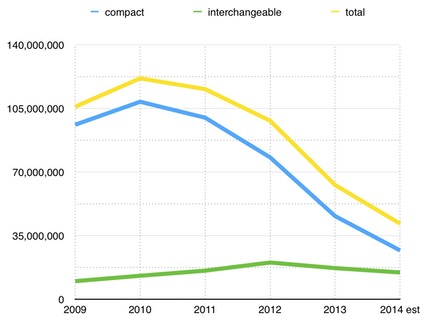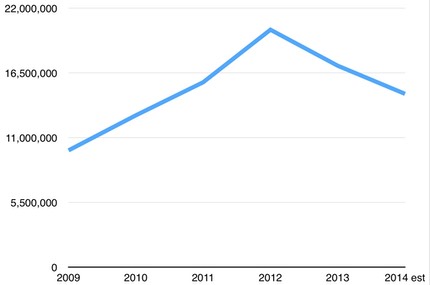
That’s the state of camera shipments through May 2014*. If the camera companies didn’t already realize that the tailspin is continuing unabated, they should now.
*To get the graph I took the January through May numbers for each year and then forecast the final year-end numbers using last year’s January-May results. Each year from 2009 the “Christmas Effect” has gotten lower, by the way, consistent with the consumer attitude that cameras aren’t as desirable an item to buy now as they used to be.
Should you think that green line—which is what most readers of this site are interested in—isn’t all that bad, here it is graphed on its own:

Seems clear, right? Total camera shipments from the Japanese companies peaked four years ago, while interchangeable lens camera shipments peaked two years ago (even mirrorless, though mirrorless is flat from 2013 to 2014 so far).
Unfortunately (or fortunately depending upon what you’re looking for), that means more products like Nikon Df and Leica Monochrom. Why? Because as sales decline, unserved niches become more important. Mirrorless is hanging on in the smaller/lighter niche, the RX100 is making do in the quality pocket niche, Sony will soon enter the monochrome niche. Indeed, niches seem to be most of Sony’s strategy now.
All those buy-with-lens savings offers we’re seeing (and will see even more of soon) are another way the Japanese companies are trying to keep their sales and profit numbers up, but it doesn’t seem to work as well as it used to for a quick boost to the bottom line.
So what do you do if you’re a camera maker? Shore up the main product line and get the niche products right. In case Nikon’s reading this, here’s my advice for them:
- Make a monochrome D810 and keep its price under US$4000. Given that price, at least 10% of the D810 users will buy one. Not in place of a D810, but in addition to.
- Make the D4x with the D810 sensor. Don’t price it at US$8000, but rather no higher than US$6000. It’ll sell at least as well as the D3x did.
- Read all the complaints about the Df and make the Df Mark II. Excuse me, Df10 ;~). It needs to be 10% smaller and lighter at a minimum, and all the retro stuff needs to actually be fully user tested and rationalized, not cobbled from a napkin made at a lunch meeting. Doing so will extend the life of the Df by a year or two, and might even give it another small upwards spike at release.
- Put the D4s sensor in the D800 body and call it a D710. Sure, it’ll clip D4s sales and maybe Df10 sales (though not if the Df is properly size reduced and re-rationalized), but the majority of the D4s and Df sales have already been made.
- Make a C4. Stop giving lip service to video and just make a dedicated video camera from the DSLR base ala what Canon did. This would be the toughest of the niche products I’ve listed so far, as Nikon has a lot they still need to do on the video side, but they’ve shown competency if not urgency so far. To play in today’s world, though, this would have to be a 4K device.
- Make the Nikon1RX100: Take the V3 body down in size just a bit and put in a 24-70mm fast collapsing zoom. Don’t base it on the S4 or J4; the controls have to be prosumer niche, not consumer niche.
- Rejuvenate the dead. Radio controlled Speedlights, a modern 24-70mm f/2.8 with VR, promote the new radio remotes correctly.
What about DX, you say? This is the “shore up the main product line” bit, I think. There’s not much wrong with the D3300, D5300, and D7100 other than they need to go on a diet and they need far, far better DX lens support than a gaggle of 18-xx zooms.
Which brings me to Photokina in September. This is a make or break Photokina for a lot of companies and the industry in general. There needs to be lots of exciting products that can rejuvenate the market somewhat or else there will be a big danger of just ratifying the current overall view that cameras are dying. That also means there needs to be new technologies, which makes this a tightrope walk for the camera companies.
The rumor mill is talking about Canon introducing the 7D update with a new sensor technology, for example. That’s the tightrope problem in a nutshell. First, there are plenty of APS crop DSLR bodies on the shelves at the moment that still need to be sold. An individual model update just puts one model’s inventory into play. A new sensor technology puts the whole existing inventory into question. Thus, it’s a tricky place to be. Still, if the rumor is true, it would indicate that Canon is probably doing the right thing. Cameras aren’t going to revive—or even maintain current sales levels—without a big reset in user’s minds. We desperately need a reinvention of the camera in some way to restart the sales cycle. A new sensor technology might be part of that.
Yet there’s that “good enough” thing that I’ve been writing about for awhile now. More and more potential purchasers are peeling off and getting out of the upgrade cycles as they believe what they already own is good enough. I could probably list a couple of dozen cameras that are good enough for 90% of all semi-serious photographers at this point. So better sensors or more features aren’t exactly the answer the industry needs.
What I’m looking for at Photokina this year is someone, anyone, that understands that workflow is the answer to redefine the camera and re-ignite the photography sales space. I haven’t seen one Japanese camera company that gets this yet. I can assure you that Apple and even Google get it.
So I suspect we’re doomed towards the increasingly niche approach until a startup somewhere pulls a rabbit out of their virtual hat and disrupts everyone.
Me: Siri, I’m shooting landscapes at sunrise.
Siri: I’ve set the camera to your preferred landscape settings, Thom, what do you want me to do with the images?
Me: Keywords Patagonia, Torres del Paines, South America, Chile, Cuernos, Sunrise.
Siri: Save in International folder, South America, Chile, Patagonia, Torres?
Me: Yes. Filename is date, location, camera, sequence.
Siri: Noted. Example 20141225-INT-CHILE-PAT-TORRES-D5-0001.
Me: Initial processing using Landscape Demosaic, flag any image that doesn’t conform to my normal linearity test, fails my in focus test.
Siri: Noted. Process raws with Landscape Demosaic script, linearity flag script, focus script.
Me: combine all images marked pano or HDR from the camera.
Siri: Noted. Images marked pano or HDR will be processed together into one image.
Siri: An email with links to all results and messages from scripts will be sent when done.





